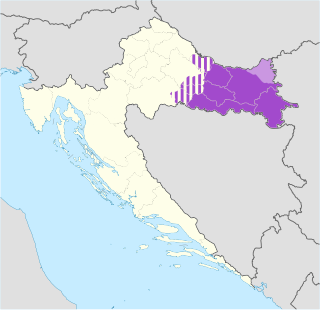
Slavonia is, with Dalmatia, Croatia proper, and Istria, one of the four historical regions of Croatia. Located in the Pannonian Plain and taking up the east of the country, it roughly corresponds with five Croatian counties: Brod-Posavina, Osijek-Baranja, Požega-Slavonia, Virovitica-Podravina, and Vukovar-Syrmia, although the territory of the counties includes Baranya, and the definition of the western extent of Slavonia as a region varies. The counties cover 12,556 square kilometres or 22.2% of Croatia, inhabited by 806,192—18.8% of Croatia's population. The largest city in the region is Osijek, followed by Slavonski Brod and Vinkovci.

Vukovar is a city in Croatia, in the eastern regions of Syrmia and Slavonia. It contains Croatia's largest river port, located at the confluence of the Vuka and the Danube. Vukovar is the seat of Vukovar-Syrmia County and the second largest city in the county after Vinkovci. The city's registered population was 22,616 in the 2021 census, with a total of 23,536 in the municipality.

Vukovar-Srijem County, Vukovar-Sirmium County or Vukovar-Syrmia County, named after the eponymous town of Vukovar and the region of Syrmia, is the easternmost Croatian county. It includes the eastern parts of the region of Slavonia and the western parts of the region of Syrmia, as well as the lower Sava river basin, Posavina and Danube river basin Podunavlje. Due to the overlapping definitions of geographic regions, division on Slavonia and Syrmia approximately divides the county vertically into north-west and south-east half, while division on Posavina and Podunavlje divides it horizontally on north-east and south-west half.

Syrmia is a region of the southern Pannonian Plain, which lies between the Danube and Sava rivers. It is divided between Serbia and Croatia. Most of the region is flat, with the exception of the low Fruška gora mountain stretching along the Danube in its northern part.
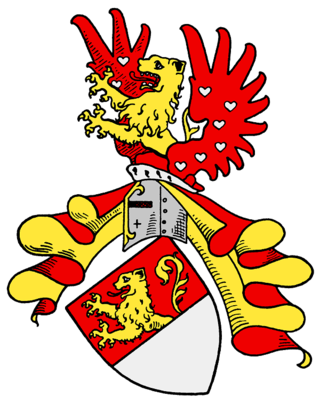
The Eltz family is a noted German noble family of the Uradel. The Rhenish dynasty has had close ties to the Kingdom of Croatia-Slavonia since 1736.

Borovo, also known as Borovo Selo, is a village and a municipality in Vukovar-Syrmia County in eastern part of Croatia. Situated on the banks of the Danube river, it shares its border with Serbia and the municipality of Bač on the opposite side. The historical development of Borovo is intricately linked with the Danube, which has played a pivotal role in its development as a notable industrial hub in the region.
Podunavlje is the name of the Danube river basin parts located in Croatia and Serbia. Podunavlje is located on the southern edge of Pannonian Basin. In its wider meaning, the Croatian term refers to the area around the entire flow of the river Danube.

The Serbian Autonomous Oblast of Eastern Slavonia, Baranja and Western Syrmia was a self-proclaimed Serbian Autonomous Oblast (SAO) in eastern Croatia, established during the Yugoslav Wars. It was one of three SAOs proclaimed on the territory of Croatia. The oblast included parts of the geographical regions of Slavonia, Baranja, and Syrmia along the Croatian section of the Danube river Podunavlje region.

The Battle of Vukovar was an 87-day siege of Vukovar in eastern Croatia by the Yugoslav People's Army (JNA), supported by various paramilitary forces from Serbia, between August and November 1991. Before the Croatian War of Independence the Baroque town was a prosperous, mixed community of Croats, Serbs and other ethnic groups. As Yugoslavia began to break up, Serbia's President Slobodan Milošević and Croatia's President Franjo Tuđman began pursuing nationalist politics. In 1990, an armed insurrection was started by Croatian Serb militias, supported by the Serbian government and paramilitary groups, who seized control of Serb-populated areas of Croatia. The JNA began to intervene in favour of the rebellion, and conflict broke out in the eastern Croatian region of Slavonia in May 1991. In August, the JNA launched a full-scale attack against Croatian-held territory in eastern Slavonia, including Vukovar.
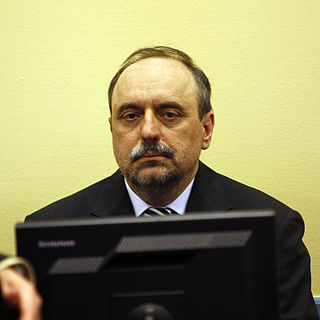
Goran Hadžić was a Croatian Serb politician and President of the self-proclaimed Republic of Serbian Krajina, during the Croatian War of Independence. He was accused of crimes against humanity and of violation of the laws and customs of war by the International Criminal Tribunal for the former Yugoslavia.

Negoslavci is a village and a municipality in Vukovar-Syrmia County in eastern Croatia. It is located south of the town of Vukovar, seat of the county. Landscape of the Negoslavci Municipality is marked by the Pannonian Basin plains and agricultural fields of maize, wheat, common sunflower and sugar beet.
The Lovas killings involved the killing of 70 Croat civilian residents of the village of Lovas between 10 and 18 October 1991, during the Croatian War of Independence. The killings took place during and in the immediate aftermath of the occupation of the village by the Yugoslav People's Army (JNA) supported by Croatian Serb forces and Dušan Silni paramilitaries on 10 October, two days after Croatia declared independence from Yugoslavia. The occupation occurred during the Battle of Vukovar, as the JNA sought to consolidate its control over the area surrounding the city of Vukovar. The killings and abuse of the civilian population continued until 18 October, when troops guarding a group of civilians forced them to walk into a minefield at gunpoint and then opened fire upon them.
Jakob Graf und Edler Herr von und zu Eltz-Kempenich genannt Faust von Stromberg, also referred to as Johann Jakob Eltz was a Knight of Malta, and a Croatian politician who became a key figure in Croatian politics during the 1990s. In Croatia, he is often styled as the count of Vukovar. He was President of the Association of Winemakers in Rheingau from 1964 to 1976. Jakob von und zu Eltz is the maternal grandfather of Karl-Theodor zu Guttenberg, a former German Minister of Defence.
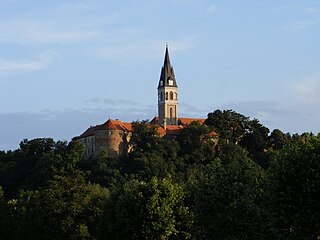
Ilok Castle or Odescalchi Castle overlooks the town of Ilok in eastern Croatia. It is built on a hill above the town centre, offering views on the Danube and the Pannonian Plain.

Srijemske Laze is a village in Stari Jankovci municipality of Vukovar-Syrmia County in eastern Croatia. The village is physically connected with the village of Slakovci. According to 2011 census there is 566 residents in the village. The largest ethnic group in the village are Serbs of Croatia. The village is connected with the rest of the country by the D46 state road connecting it with the town of Vinkovci and continuing into Serbia as the State Road 120 to the nearest town of Šid. Surrounding landscape of the village is marked by the Pannonian Basin plains and agricultural fields of corn, wheat, common sunflower and sugar beet.
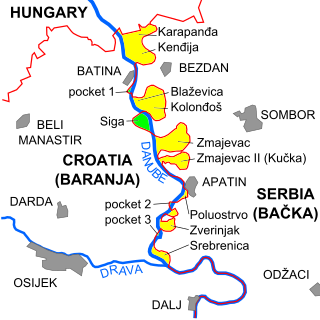
The border between Croatia and Serbia in the area of the Danube is disputed, an important part of their broader diplomatic relations. While Serbia claims that the thalweg of the Danube valley and the centerline of the river represents the international border between the two countries, Croatia disagrees, claiming that the international border lies along the boundaries of the cadastral municipalities located along the river—departing from the course at several points along a 140-kilometre (87 mi) section. The cadastre-based boundary reflects the course of the Danube which existed in the 19th century, before anti-meandering and hydrotechnical engineering works altered its course. The area size of the territory in dispute is reported variously, up to 140 km2.

Remembrance Day or Day of Remembrance for the Victims of the Homeland War and Day of Remembrance for the Victims of Vukovar and Škabrnja it is a national public holiday in the Republic of Croatia and a non-working day in memory of all victims of the Homeland War in Croatia. The holiday is celebrated on November 18, the day of the fall of the city of Vukovar in the 1991 Homeland War, when the Yugoslav People's Army and Serbian paramilitaries committed the two most massive crimes in Croatia during the Croatian War of Independence in two Croatian towns, Vukovar and Škabrnja. These events are known as Vukovar massacre and Škabrnja massacre. In memory of these events, the Croatian Parliament in 2019 has adopted a new law which introduced a new holiday, a day of remembrance for all victims of the Croatian War of Independence.

Palace of Syrmia County is located Vukovar, administrative seat of the Vukovar-Srijem County. The building originally housed the assembly and institutions of the Syrmia County with subsequent occupants listing various historical administrative units and including contemporary regional authorities of the Vukovar-Srijem County.

Church of the Saint Archangel Michael in Ilok is a Serbian Orthodox church in eastern Croatia. Contemporary church was built in 2016 as an exact copy of the previous church which was built at the same location between 1798 and 1802 and which was destroyed in 1942 during the Genocide of Serbs in the Independent State of Croatia during the World War II in Yugoslavia. An older Serbian Orthodox church was constructed further away from the centre of the town in 1702 but at the time of construction of the new church that building was already ruined.

The Lordship of Vukovar was a large land estate, lordship, established in the Kingdom of Slavonia in 1731, after the liberation of the region from the Ottoman rule following the 1699 Treaty of Karlowitz. The seat of the lordship was in the town of Vukovar, on the banks of the Danube river where between 1749 and 1751 representative Eltz Manor was constructed. The lordship existed until the end of the World War II in Yugoslavia and the establishment of the Federal People's Republic of Yugoslavia in 1945. Significant part of its agricultural estates was subsequently run by the agricultural production company—Vupik.

























